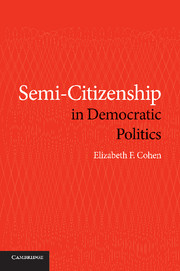Book contents
3 - An Introduction to Semi-Citizenship
Published online by Cambridge University Press: 02 February 2010
Summary
Hence, as is evident, there are different kinds of citizens.
INTRODUCTION
Understanding semi-citizenship requires a framework that avoids reductiveness while still identifying distinctions among different kinds of citizens. It must rely on a complex and yet parsimonious set of criteria from which we can extract several, although not an infinite number of, varieties of semi-citizenships, and into which we can categorize various persons and groups that obviously hold different forms of semi-citizenship. An effective method of classification will identify forms of semi-citizenship, facilitate comparisons across them, and shed light on the institutions and processes involved in governing semi-citizenships.
Moving beyond criticism of overly unitary or narrowly normative understandings of citizenship requires a careful discussion of how citizenship becomes “unbundled” and an examination of exactly how the constitutive elements of citizenship appear in the absence of one or several of their counterparts. Doing this in turn entails addressing the implications of the second obstacle to defining citizenship that I noted in Chapter 2. That is, the difficulty associated with a gradient category that is susceptible to the Sorites Paradox. Both the content (the bundle of rights that citizenship comprises) and the criteria (the bases upon which each right is awarded) involve imprecise thresholds; there is no single recipe for determining exactly which rights make up a type of citizenship, nor can we identify exactly when someone is mature enough, intelligent enough, or well enough established in a territory to be called a citizen.
- Type
- Chapter
- Information
- Semi-Citizenship in Democratic Politics , pp. 59 - 94Publisher: Cambridge University PressPrint publication year: 2009



